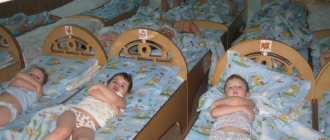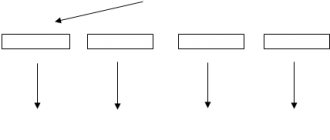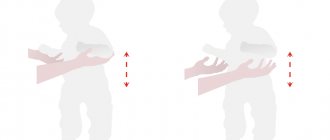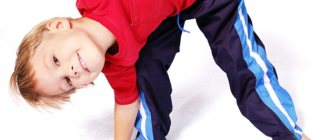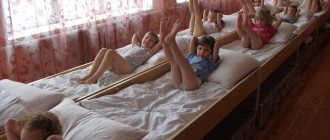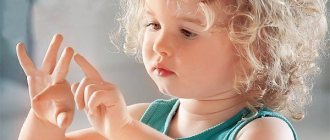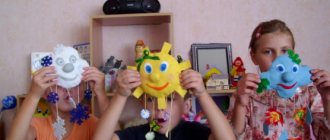Exercises in kindergarten as part of the general educational process
Kindergarten pupils must grow up healthy so that they develop the required skills and abilities, as well as abilities. A healthy baby is well trained, understands what the teacher wants from him, and is interested in learning new things. Exercise, which is a systematic activity in kindergarten, helps with this.
Charging at a preschool educational institution
Its goal is to preserve and strengthen the psyche and the body as a whole. The main task is to create a positive emotional mood. Morning exercises (MG) are an integral part of the physical training regime for preschool children. This is a set of special exercises for muscle tissue and joints.
Exercises for preschoolers can be carried out as part of activities that have a positive effect on the respiratory system and games for fine motor skills. UG can take place together with the hardening technique. In addition to health-saving functions, exercise in a preschool educational institution is important for the formation of mental processes, broadening one’s horizons, and communication skills.
Important! During ultrasonography, endorphin, the hormone of happiness, is actively produced. It improves mood and protects against negative thoughts.
A boost of energy from performing gymnastic exercises
Goals and objectives of the UG
Gymnastics in preschool educational institutions is divided by age groups: 2-3 years, 3-4 years, 4-5 years, 5-6 years, 6-7 years. The physical component is important for the entire period of education. The purpose of exercise in kindergarten is to instill a desire to monitor your health throughout your life.
Every day the morning in kindergarten begins with a training session, which makes it possible to strengthen the little body.
For your information! It is important to instill in a person a love of physical education from childhood; in kindergarten they lay the foundation for the future. The goal of UG is to improve the functioning of body systems.
Exercise has enormous health-improving and educational significance. Many preschool teachers find it difficult to create a set of activities that will be more effective for children of different ages, and they use the recommendations of the Federal State Educational Standard.
Every morning in most kindergartens in Russia begins with UG. The purpose of exercise is to develop body muscles and improve health conditions. The baby’s body needs physical exercise, it needs to release energy. It can be directed in the most useful direction by involving preschoolers in active and interesting exercises and exciting games.
Exercise is important in organizing the day and for the well-being of the students. Those who are already awake and starting to pamper will become calmer with the help of exercises. Sleepy and inactive guys, on the contrary, will cheer up. The purpose of exercise is to normalize discipline. You should exercise daily so that your baby gets used to organized sports. Then it will not cause negative emotions and fatigue, but, on the contrary, will turn into pleasure.
For your information! It is important to choose sets of exercises according to the age and capabilities of preschoolers.
Morning exercises as part of the educational process in kindergarten
All parents know the importance of doing physical exercise after waking up. But in modern life it is not always possible to maintain the correct daily routine. Admission of children to kindergarten begins at 7:00, and parents bring many children without exercise and without breakfast. Therefore, the approximate start of a weekday for preschoolers is as follows:
- 6:30–7:00 — get up, morning toilet at home;
- 7:00–8:10 — admission to the kindergarten group;
- 8:10–8:30 — morning exercises;
- 8:30–9:00 – breakfast.
What is charging for? - This is not a riddle at all - To develop strength And not get tired all day.
P. A. Sinyavsky
Morning exercises are designed to invigorate children and provide a positive emotional mood
Children should grow up healthy so that the necessary skills and abilities are easily formed and their abilities are actively developed. A healthy child is receptive to learning, understands the requirements of the teacher, and his natural interest in learning is strengthened. Therefore, exercise is a regular activity in kindergarten. The goals of morning (hygienic) gymnastics in preschool educational institutions are to preserve and strengthen the physical and mental health of preschoolers and create a positive emotional tone.
Doing exercises strengthens both physical and mental health - the child experiences positive emotions
Morning exercises are part of children’s physical activity regimen. It is a set of physical exercises for muscles and joints. Exercises for preschoolers are often supplemented with elements of breathing exercises and finger games. Morning exercises can be combined with hardening techniques. In addition to health-saving functions, exercise plays a significant role in the development of mental processes, communication abilities, and the expansion of cognitive interests. Morning exercises are one of the tools for raising a comprehensively developed personality.
In the process of performing exercises, preschoolers train attentiveness
Interesting fact. During exercise, endorphin is actively produced - the hormone of joy. It is responsible for a good mood and blocks negative emotions.
Table: tasks of morning exercises in different kindergarten groups
| Development area | First and second junior groups (1.5–4 years) | Middle group (4–5 years old) | Senior and preparatory groups (5–7 years old) |
| Physical development |
|
|
|
| Mental development |
|
|
|
| Moral development |
|
|
|
Doing morning exercises helps the body wake up
Types of morning exercises
Complexes of morning exercises are implemented according to general principles:
- accessibility: exercises and games correspond to the physical training of preschool children, explanations and demonstrations are clear;
- efficiency and benefits: exercise develops children, improves their physical condition;
- positivity: preschool children do exercises for a good mood; if the child is not inclined to physical activity (sick, upset), he is not forced to exercise.
For exercise to become a habit among children, it must captivate them and bring joy. To create sustainable motivation for preschoolers to do morning exercises, the teacher selects interesting exercises, conducts classes in a playful way, or uses unusual equipment. Let's take a closer look at what exercises are like in kindergarten.
General developmental gymnastics is a simple set of exercises, not united by any plot, aimed at stimulating motor activity. Performing movements, as a rule, takes place according to poetic texts or to musical accompaniment. Audio exercises are carried out in kindergarten from the first junior group; the melody helps children feel the pace of movements. Morning exercises can be performed with live accompaniment in the music room or using audio recordings.
Video: morning exercises “Pioneer Dawn”
“Pioneer Dawn” was familiar to all children in the USSR. Every morning, the cheerful voice of the announcer on the All-Union radio greeted the Octobrists and Pioneers. Pleasant instrumental music sounded and clear commands for movements were given. Currently, the activities of the pioneer organization are being rethought and reassessed; the movement continues to exist, preserving the time-tested methods of Soviet pedagogy. Classical exercises accompanied by upbeat music are carried out in kindergartens and schools.
Physical and play exercises can be combined by a theme in accordance with the work program. Thematic gymnastics in kindergarten is associated with the natural calendar and holidays: “Autumn”, “Winter”, “Spring”, “February 23”, “March 8”, “Cosmonautics Day”, etc. Songs, melodies, and poetic material are devoted to the general theme , attributes, role masks or caps.
Video: themed morning exercises “Winter” in the middle group
Plot exercises are a set of exercises united by a theme or built on a simple plot. Younger preschoolers love stories and poems about animals; “Bird exercises” and “Exercise about animals” are held with them. For older children, the complexes “Training of future cosmonauts”, “Atty-bats, we are soldiers”, “Sea voyage” are interesting. Exercises in story gymnastics are connected by a fictional story or an educational story: about the habits of animals and birds, about service in the army and navy, about the training of astronauts, etc.
Video: morning exercises “Journey to Murland” for children 3–4 years old
“Journey to Murland” is an excellent example of morning exercises for young children. The teacher prepared a set of exercises together with the music director: during exercises, wonderful rhythmic melodies are heard and songs are sung. The room is decorated with images of cats and plush toys. Mustaches are drawn on the faces of the children and the teacher. The children happily strive to get to a magical land, completing tasks for this purpose, and themselves “reincarnate” into kittens.
Morning exercises on beds and pajama exercises are exercises that are performed immediately after waking up. This type of charging is possible in 24-hour preschool educational institutions and five-day kindergartens, where preschoolers spend the full day, including staying overnight. Pajama gymnastics helps the whole body wake up: tissues and internal organs are actively saturated with oxygen - the muscles and brain become toned. They won’t say about a child doing gymnastics immediately after getting up: “They lifted him up, but they forgot to wake him up.”
Video: gymnastics after sleep in kindergarten
Awakening gymnastics is also carried out in the middle of the day - after a quiet hour. The same sets of exercises for the first and second half of the day are used - aimed at gently awakening the body. As shown in the video, it is correct to perform the exercises while listening to quiet, slow music. You can use audio recordings of natural sounds with instrumental accompaniment (bird songs, sounds of the forest, the sound of rain or sea).
Non-traditional exercises include gymnastic complexes using unusual equipment. These are homemade items from waste material: expanders, sensory mats and tracks, rattles, dumbbells made from plastic bottles. Under the supervision of a physical education instructor, exercises are carried out with elements of aerobics (on step platforms) and the use of sports equipment (mini-trampolines, treadmills).
Video: morning exercises on step platforms in the preparatory group
As we can see, the exercises are carried out by an instructor in the gym. The step platform seems like a simple attribute. But incorrect aerobic exercise technique can lead to excessive stress on the joints and even injuries. To carry out such exercises, consultation with a physical trainer is not enough; constant monitoring of aerobic activity is necessary.
Principles of gymnastic complexes
Morning exercises in kindergartens for preschool children were compiled by specialists. Complexes in children's educational institutions are carried out according to the principles:
- Accessibility: tasks and games correspond to the physical training of students, explanations and demonstrations of exercises are clear.
- Effectiveness and benefits: gymnastics develops preschoolers and improves their health.
- Positive: preschoolers do UG for a great mood; if the child is not inclined to exercise (sick, upset), he should not be forced to do the exercises.
A complex of invigorating exercises after a nap in kindergartens
For gymnastics to become a habit among preschoolers, it must interest them and evoke only positive emotions. To ensure students’ persistent motivation for classes, the teacher must choose interesting exercises, conduct them in the form of a game, or use original equipment.
Exercise demonstration
Text material for morning exercises in preschool educational institutions
Like any type of children's activity, exercise is accompanied by verbal creativity. Children's folklore exists in outdoor games and morning exercises in the form of short rhythmic texts. With their help, preschoolers invite their friends to exercise, encourage them to do productive work, accompany marching, greet each other and say goodbye.
Morning exercises, unfortunately, exist as an activity organized by an adult. Rhymes and mottos are passed down not from child to child, but from a teacher or parent to the younger generation. Therefore, in kindergarten, the teacher encourages children to memorize and repeat texts so that one day they can use them in doing gymnastics with their children.
Cheers for exercises can be used in the design of a sports corner in a group
Examples of chants for morning exercises in kindergarten:
- In order to grow and harden, not by the day, but by the hour, we need to do physical education.
- Accustom yourself to order, do exercises every day. Laugh, laugh more, you will be healthier.
- Everyone knows, everyone understands that it’s nice to be healthy. You just need to know how to become healthy.
- Let them fly to our room. All the snowflakes are white! We're not cold at all - We've done our exercises.
- The tough kids came out onto the playground. The tough kids did their exercises.
- Exercise is useful for everyone, Everyone needs exercise. She saves us from laziness and illness.
- Do exercises every day: fatigue, lethargy, laziness will go away.
- If someone runs away from exercise without looking back, He will not become a real strongman!
Children love sayings. Saying or shouting the motto in chorus is fun, at least. And most importantly, there is a sense of group cohesion, thanks not only to the phrase spoken by everyone together, but also to work towards a common important goal - maintaining health.
Table: examples of thematic poems for exercises (compiled based on open access materials)
| Subject | Text of poems |
| About physical education |
|
| About animals |
|
| About nature |
|
| About fairy tales |
|
Methods for doing exercises in kindergarten
Carrying out an educational session is a responsible process, since the work involves children. Exercises for children in preschool educational institutions should be performed either by a physical instructor in the gym, or directly by a teacher directly in the group. According to the rules, UG is carried out half an hour before the first meal.
Hoop exercise
Duration recommendations
UG in each kindergarten group differs not only in duration, but also in the nature of certain exercises. Recommendations:
- The duration of the lesson in the younger group of kindergarten should not be more than 5 minutes. To make it interesting for students, exercises should take place in the form of a game with jokes and jokes. For example, kids can be asked to walk like a bear, a fox or a horse. Hula hoops, cubes and maracas are suitable for performing exercises.
- In the middle kindergarten group, the training course lasts 6 minutes. The structure of the exercise is a little more complicated than the previous one; you can add ribbons and balls as objects for exercise.
- Pupils in the senior group of kindergarten have excellent memory, so the GC can be carried out without the participation of a teacher. The teacher only has to show them how to practice once. Recommended equipment includes pigtail cords, balls, hoops and sticks. The complex can include dancing and rhythm. Lesson duration is approximately 10 minutes.
- The training session in the preparatory group of the kindergarten lasts 12 minutes and, by and large, repeats the complex of the senior group. The equipment used is jumping ropes and dumbbells. In addition, some sports elements using a wall bars can be added to the complex.
How to organize children for morning exercises
In addition to the game theme, the teacher can use other techniques to attract children to the UG. Expressive language, engaging content and positivity will help motivate students. You can play it so that they want to exercise on their own, become healthier and stronger.
An original approach will help motivate you to do morning exercises at a preschool educational institution. For example, a teacher can invite all the children to visit Winnie the Pooh, and to get there, you need to jump three times and smile. This element of the game will attract the children, and they will definitely fulfill all the conditions.
At preschool age, all children are very inquisitive. They are interested in how animals move, flowers grow and what is happening on the planet. Experienced teachers use this to organize effective exercises. They come up with a lot of playful exercises for children to exercise in the morning with the connection of characters and fictional characters.
A set of exercises for children's flat feet
Important! If a child has a certificate stating that physical activity is temporarily contraindicated for him (these are issued after an illness), you can offer him to be the presenter or observe the process from the bench.
Methodology for morning exercises in kindergarten
Morning exercises are carried out by the teacher according to pre-compiled complexes. Physical exercises and outdoor games are consistent with the physical development program: children perform familiar movements and are not taught new games during exercise. Gymnastic complexes include:
- general developmental exercises for large and small muscles;
- breathing exercises and exercises to strengthen the cardiovascular system;
- drills and games: formation, formation, turns.
For each kindergarten group, 10–12 sets of morning exercises are planned. They are repeated throughout the school year with gradual complication of the exercises, supplemented with new images, poetic texts, and music.
Morning exercises include drill exercises, for example, formation in columns
Table: stages of morning exercises
| Gymnastics stage | Content |
| Gathering for charging, building |
|
| Walking |
|
| Run |
|
| Jumping |
|
| General developmental exercises |
|
| Running at a fast pace |
|
| End of charging |
|
While performing gymnastic exercises, children work out various muscle groups.
Recommendations for charging
Morning exercises are carried out in a spacious, bright room - in a group, music or gym. The room is well ventilated before the lesson begins. The teacher and students wear comfortable clothes and shoes, preferably sportswear. Gymnastics after waking up (in 24-hour gardens) is carried out without first changing clothes - next to the beds, in pajamas or T-shirts.
Clothes for exercise should be comfortable, the same sports uniform on students looks aesthetically pleasing
In the warm season, morning exercises are recommended to be done in the fresh air - on a group site. The nature and intensity of the exercises are selected by the teacher in accordance with the temperature and clothing of the children: the colder it is outside, the more active the physical activity. In autumn, with the onset of frost and winter, exercises are carried out outside with sufficiently prepared children for the purpose of hardening.
During the warm season, the teacher and children perform morning exercises at the preschool site
The teacher does exercises together with younger preschoolers: children repeat the movements of the adult. Starting from the middle group, the teacher gives a verbal description of the exercises, draws attention to difficult movements and demonstrates the technique. Children 4–7 years old do morning exercises on their own (unless a lesson with special unfamiliar equipment/simulators is provided). One of the students is selected to demonstrate the movements. The teacher monitors all children’s exercises and corrects technical errors in movements individually. The teacher does a separate exercise with the children when he feels the need to remind them of the movements (for example, based on the name of the exercise, the children did not remember all the movements or they confuse the order of actions).
Senior preschoolers perform gymnastic exercises without the instructor demonstrating the movements
During morning exercises, the teacher uses oral counting and verbal instructions, alternates them, thereby asking ri, “right-right, left-left” (bending the body). When the instructor becomes an observer, he must continue to count (this cannot be entrusted to the child demonstrating the movements). In older groups, gestures are added to verbal instructions: moving the hand down - the children squat down, hand up - they stand in the starting position.
For different age groups, exercises are selected that are accessible to all children. They begin to complete each task simultaneously, counting with verbal instructions. The younger ones finish performing and rest, the older ones do additional approaches to count.
When one of the students demonstrates the movements, the rhythm of the exercise is set by the teacher using mental counting.
Table: examples of thematic complexes for different age groups
| Age group | Name of the complex | Content |
| First youngest | "Barbariki" |
|
| Second youngest | "Radiant sun..." |
|
| Average | "Golden Autumn" |
|
| Older | "Traffic Regulations" (Traffic Regulations) |
|
| Preparatory | "Let's fly into space" |
|
Duration of morning exercises
The total duration of the exercise (from the signal to gather to the command to disperse after gymnastics) is determined by the age of the children:
- in the first younger group - 4–5 minutes;
- in the second youngest - 5–6 minutes;
- on average - 6–8 minutes;
- in the older ones - 8–10 minutes;
- in the preparatory room - 10–12 minutes.
The pace of morning exercises is high. As little time as possible is allocated for demonstrating movements, verbal instructions, and distributing attributes. The older the students, the shorter the interval between exercises.
The distribution of equipment should take a minimum of time, so simple items for charging are selected (for example, a rope with a load)
Table: approximate time plan for morning exercises “Barbariki” in the first junior group
| Charging stage | Duration |
| Organizational moment, formation | 0.5 minutes |
| Walking | 1.5 minutes |
| General strengthening exercises | 2 minutes |
| Construction, completion of charging | 0.5–1 minute |
Table: approximate time plan for morning exercises “SDA” in the senior group
| Charging stage | Duration |
| Organizational moment, formation | 0.5 minutes |
| Walking and running | 1.5 minutes |
| Breathing exercise | 1–1.5 minutes |
| General strengthening exercises | 3–5 minutes |
| Running without a break | 0.5 minutes |
| Restoring breathing, completing charging | 1 minute |
Table: summary of the exercise “Morning exercises with the cat Leopold” (fragment)
| Author | Afanasyeva M., teacher at MBDOU D/s No. 588, Ekaterinburg, Sverdlovsk region. |
| Target | Help strengthen children's health and awaken the body for normal functioning. |
| Introductory stage | The teacher asks a riddle about a cat and says that today the cat Leopold will do exercises with them.
|
| Main part | Outdoor switchgear complex without items:
|
| Final part |
|
| Quote from: https://www.maam.ru/detskijsad/utrenja-gimnastika-s-kotom-leopoldom.html | |
A set of exercises for UG
Typically, gymnastic exercises in preschool educational institutions are carried out according to a prepared plan. What a standard complex looks like:
- The lesson begins with walking in place or running in a circle. Children can walk and run in a column around the room or veranda, then in pairs or one at a time. You need to run in all directions to finish this block.
- Then the children swing their arms up and down, sideways and in a circle. This helps strengthen the shoulder muscles.
- Next, gymnastics is performed for the muscles of the lower extremities. The guys swing their legs, move them one by one to the side, lift them, bend them and stand them straight. Squats are a must.
- Why are body tilts and turns involved? These exercises are used to strengthen the back and torso.
The exercise ends with light walking in place, breathing exercises or finger games.
Tilting the body to the side
Texts for exercises in preschool educational institutions
The goal of the UG is to unite students and establish good relationships between them. The children study together, and this brings them closer together. Therefore, it is very important to do group exercises every day, thanks to which the baby will become stronger and more sociable. Rhythmic exercises are excellent to combine with entertaining poems. For this purpose, special text material has been developed. Students will enjoy practicing while listening to poetry. The texts are simple; by pronouncing them faster or slower, you can speed up the pace of your lessons or, conversely, slow them down.
Poems for gymnastics
Having learned gymnastic exercises in poetic form, children will be able to do exercises on their own without the help of a teacher, focusing on the meaning of the poem. And if adults also perform the exercise together with preschoolers, then the child is more likely to feel the significance and benefit that it can bring to everyone. In addition, poetry helps to develop.
Important! To begin with, you can try to learn the poem “Potyagushki”.
Analysis of morning exercises
Each teacher must keep a file of children, analyze and monitor classes and the condition of each child. UG analysis plan:
- age and number of preschoolers in the group;
- gymnastics venue;
- how preschoolers and the teacher are dressed;
- exercise exercises and duration;
- development tasks at each stage: what was accomplished, compliance with the stated duration;
- the effectiveness of pedagogy: display, text instructions, equipment, individual assistance;
- emotional state of preschoolers at each stage of classes;
- conclusion: whether changes or additional exercises will be required in the exercises.
For your information! Thanks to analysis and diagnostics, it is possible to summarize and improve charging, and the control chart will allow you to identify shortcomings.
Sample of filling out a card
GC, which is carried out in a preschool institution every day, will make the baby more dexterous, energetic, help avoid a number of problems in the normal functioning of the musculoskeletal system, increase immunity, strengthen the psyche and teach interaction with other children. And by doing it in the form of a game, you can make physical exercise not only healthy, but also fun.
Basic rules for morning exercises for children
There are general rules that are always followed, regardless of age:
- exercises are done on an empty stomach, and to help the body wake up, you can first wash your face and drink a glass of water;
- the room should be well ventilated, it is even better to practice directly in the fresh air;
- most of the complex should consist of warm-up and stretching, and strength exercises should be avoided;
- watch your breathing: there should be no delays, there should be a rhythmic cycle of inhalation (through the nose) and exhalation (through the mouth).
- Hardening procedures (contrast shower or washing with cold water) and a healthy breakfast will help to consolidate the positive result.
In childhood, it is especially important that activities are interesting. Therefore, choose cheerful, upbeat music and change the exercises for children from time to time: add new movements, complicate them, come up with funny names for the exercises.
